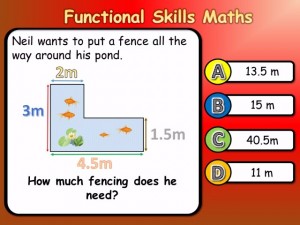Last week I challenged you to play the game that everyone is talking about – and by everyone, I mean me – Guess the Misconception. I asked you to predict the most popular incorrect answer that students gave to the following question on missing lengths.

My theory is that often we as teachers hold beliefs about students’ understanding – or indeed their misunderstanding – of a concept that are not actually true. This leaves us in danger of focussing our teaching and our interventions on the wrong areas.
Well, in this case, I am wrong! You correctly predicted that option D would be the most common student misconception. Here are a few of the explanations that students gave for it:
Because if you add all the numbers up it gives you the perimeter. 2m+3m+4.5+1.5=11m
I know this because i added up all of the side witch gave me the answer
Because 2 + 3 + 4 point 5 + 1 point 5 is 11
It is, however, interesting to note the popularity of option A. Here students have identified that a length is indeed missing, but still failed to get the correct answer for the perimeter as these explanations reveal:
to find out what the side is where there is no number , you pretend that you cut off where the two shapes meet and that’s at 2m and 4.5m. so then you do 4.5 -2m and that is 2.5m and then you add them all together and it equals 13.5
I think this is the answer because if you work out all the missing parts and add all of them together which gets you the answer 13.5
because 2m has been lifted up from 4.5 metres so you are left with 2.5m then you add the rest up
So, whilst the emphasis certainly needs to be first on ensuring students realise that there are missing lengths, we must be careful to also ensure they correctly identify all the missing lengths.
Anyway, that’ 1-0 to you lovely teachers on this one. I wonder if I can get you back with next week’s round of Guess the Misconception. Keep an eye out on the blog for the announcement on Sunday evening…
And remember, the full list of free GCSE Essential Skills Quizzes are available on our Collections page, along with lots of other lovely treats.

this misconception is well known and I appreciate your comments. In the very early years of schooling-ages 4-7 we stress the concept of perimeter especially with compound shapes,of moving your finger around the whole shape until you return home. I feel that if the stress is put to early on the computaion of perimeters before the concept is clear we arrive at this misconception. Thanks.